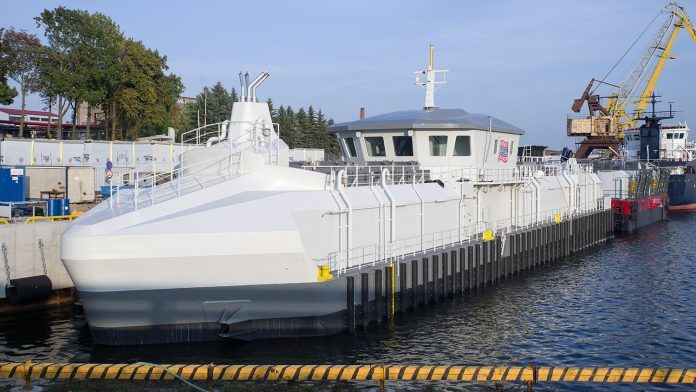Tough barge can handle “weather from all sides”.
In a press release from AKVA group, Norway Royal Salmon writes that it has invested in a new type of in steel feed barge model for its subsidiary Arctic Offshore Farming.
“A feed and service barge with a similar combination of characteristics has not previously been delivered in the aquaculture industry,” it wrote.
The barge will be used at a site west of Tromsø, Northern Norway.
“This is the toughest barge AKVA group has ever made and it can handle «weather from all sides»,” said Kent Ims Borsheim, Project Manager in AKVA group.
Unique composition
The feed and service barge AC800PVDB has a unique composition; it is over 64m long and built for extreme conditions with a total tonnage of 800 tonnes, new environmentally friendly waterborne feeding technology, and dimensioned for a wave height of 6.5m – specially designed for exposed locations.
This is also the first barge that is designed with a bottom outlet for feed hoses in order to be able to use all sides of the barge for e.g. receiving feed. In addition, the barge is equipped with an integrated boat garage that can handle boats up to 10.5m at the stern.
“We have great respect and are very grateful that NRS/AOF trusted us to develop this feed barge that represents the extreme in many ways; with requirements to withstand very harsh weather conditions, facilitated for large load capacity operations, the environmental effects of the actual feeding technology and not least a good working environment for the crew on board,” said Hans-Øyvind Sagen, Sales Director Nordic in AKVA group.
AKVA group has designed the barge with new technology for waterborne feeding. This is the second feed barge to be delivered with the new type of waterborne feeding technology.
Waterborne feeding
“With waterborne feeding, the barge is very quiet in operation and environmentally friendly,” said Borsheim.

“Waterborne feeding represents a shift to extremely low energy consumption compared to air transport of the feed,” said AKVA group. “Tests carried out during the development of waterborne feeding showed an energy reduction of as much as 70-90 per cent compared with air transport”.
“The low energy consumption in feeding represents a significant cost saving in generator operation – approx. NOK 200,000 (EUR 0.1 million .ed) in monthly savings for a conventional feeding system with 8-10 cages,” said Borsheim.
Deep feeding and constant capacity
With air feeding, the feeding capacity is up to 200kg per minute at distances up to 50m, and then the feeding capacity decreases rapidly over long distances. With waterborne feeding, feeding capacity will be almost constant, regardless of the length of the feeding hose.
“We have measured the feeding capacity of waterborne feeding up to 600m, and the feeding capacity of 100 kg was fairly constant even with this feeding hose length,” said Borsheim.
There are still issues that should be highlighted regarding the effects of waterborne feeding versus air feeding, and how the operation and technology should be adapted to optimise the operation and environmental benefits.

“Waterborne feeding also provides good conditions for “deep feeding” which is a prerequisite for exposed locations, and apart from lower lice pressure “at depth”, there are several solutions that are being worked on to facilitate good fish welfare and better growth at “deep operation”, including light conditions and feed distribution,” said Hans-Øyvind Sagen, Sales Director in AKVA group Nordic.
In 2018, NRS/AOF was awarded development licenses from the Norwegian Directorate of Fisheries to develop semi-submersible steel structures (cages) for salmon farming in Troms, Northern Norway. Two pens with a total capacity of 5990 MTB are being built. The fish farm is controlled and managed from a joint feed and service barge, developed in collaboration with, and built by, AKVA group. The pens will be ready to be stocked in the summer of 2021 with the first fish produced ready for delivery to the market by 2022.

